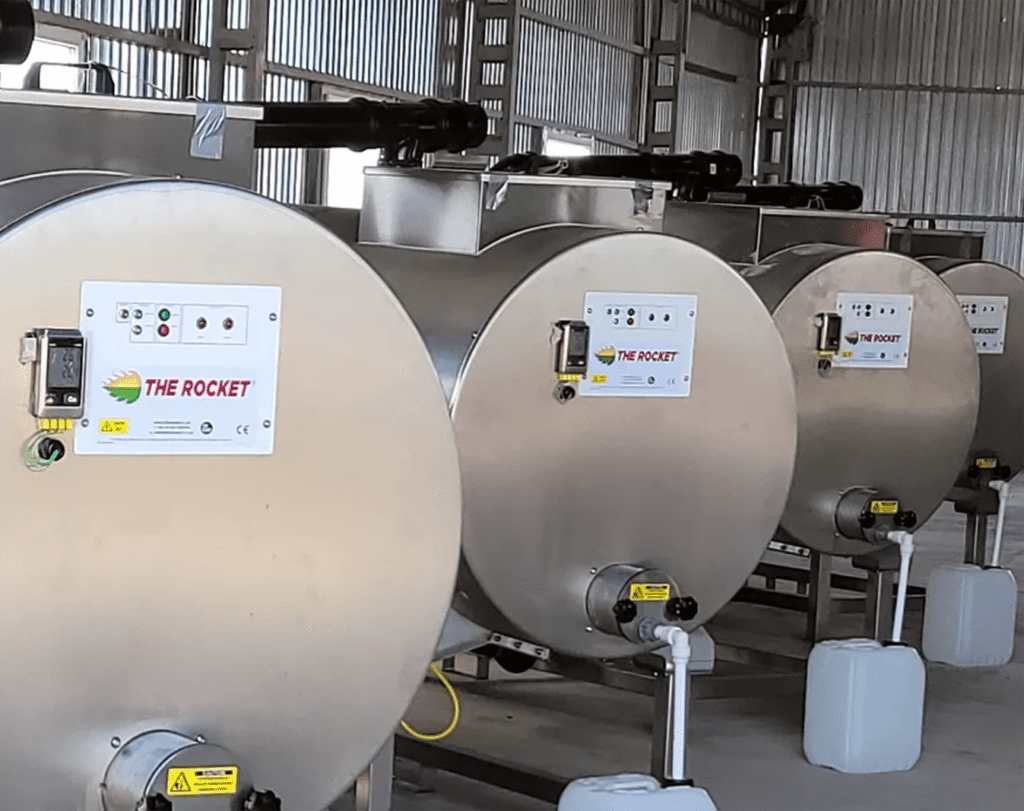Rocket Composter
Introduction →

Nature’s Recycling Power at Your Fingertips:

Sustainable Waste
Management
Reduce waste and environmental impact by composting food scraps and yard trimmings right where they are generated.

Close The
Food Loop
Turn kitchen discards into “black gold”, a natural fertiliser packed with organic matter to nourish your soil.

Capture Carbon &
Improve Soil Health
Composting combats climate change by capturing carbon and fostering healthy, productive soil.
How Does Rocket Composter Work?
The Composting Process:
Step 1.
Loading The Waste
Step 2.
Microbial Action
Step 3.
Controlled Environment
Step 4.
Aeration and Mixing
Step 5.
Conversion To Compost
Ecooffset is Offering
3 Types of Rocket Composters

A500 Rocket
Composter

A700 Rocket
Composter

A900 Rocket
Composter
A500 Rocket Composter
A500 Rocket Composter is perfect for small-scale composting as it handles up to 100 households waste, making it ideal for schools, cafes, outdoor activity centres, and community projects.

- Food waste includes all types of meat whether cooked or uncooked.
- Shredded compostable tableware.
- Animal manure and associated bedding.
- Yard scraps, green wastes, landscape debris.
- Ideal mix: 25/30:1 carbon to nitrogen ratio, ~60% moisture, porous, neutral pH.




- Process up to 40 litres of food waste per day.
- Continual flow to add fresh material input 1-3 times daily at the same time.
- The production rate of compost is approx 50%.
- The composting cycle is around 14 days.
- Manufactured in the UK for over 20 years.
- Contact components with organics made from 304-grade stainless steel.
- Designed for a 20+ year lifespan using 85% recycled European steel.
- Created to minimise wear, maintenance, and electricity consumption.
- With years of experience in composting, we deliver the highest quality support.
Length | 2.5m |
Width | 0.7m |
Height | 1.3m |
Weight | 150kg (empty) |
Capacity | Up to 40 litres of food waste per day (determined by feed materials, loading frequency and operating conditions) |
Main Motor Drive | 0.18kW |
Heater Element | 1 x 0.85kw (thermostatically controlled) |
Power Requirement | 230Vac 50hz 1ph 16 amp RCD protected |
Power Consumption | 18 kwh per week (average) |
Temperature Recording | 4 K-Type Thermocouple (Data-logger included) |
Ventilation System | Available as an ancillary (0.09kW fan) |
Housing Requirements | Min 3.5m x 2.0m covered hard standing with non porous surface |
Supplied as Standards |
|
A700 Rocket Composter
The A700 Rocket Composter is ideal for high schools, colleges, small hotels with at least 20 beds, offices with on-site catering, and community projects, efficiently managing waste from 150-300 households.

- Food waste, including cooked and uncooked meat.
- Landscaping waste, green waste, and yard scraps.
- Shredded compostable tableware.
- Some bedding materials and animal manures.
- In either case, or a combination of the above.
- Optimal mix: 25/30:1 carbon to nitrogen ratio, ~60% moisture, porous, neutral pH.




- Compost up to 100 litres of food waste daily.
- Rocket process is continual flow means that fresh material is input once, twice or three times per day concurrently.
- The production rate of compost is approximately 50% of input materials.
- Composting duration: around 14 days.
- Made in the UK for over 20 years.
- Organic contact components are made from 304-grade stainless steel.
- Engineered to reduce wear, maintenance, and electricity consumption.
- Designed for a 20+ year lifespan using 85% recycled European steel.
- With over years of expertise, we are delivering the highest quality.
Length | 3.0m |
Width | 0.9m |
Height | 1.6m |
Weight | 360 kg (empty) |
Capacity | Up to 100 litres of food waste per day(determined by feed materials, loading frequency and operating conditions) |
Main Motor Drive | 0.75kW |
Heater Element | 2 x 0.6kw (thermostatically controlled) |
Power Requirement | 230Vac 50hz 1Ph 16 amp RCD protected |
Power Consumption | ~26 kwh per week (average) |
Temperature Recording | 4 K-Type Thermocouple (Data-logger included) |
Ventilation System | Included with fan and 110mm pipework |
Housing Requirements | Min 5.0m x 2.0m covered hard standing with non porous surface |
Supplied as Standards |
|
A900 Rocket Composter
The A900 Rocket Composter is our most popular model, ideal for universities, office complexes, large hotels, oil field camps, and community projects, efficiently handling waste from 250-500 households.

- Uncooked and cooked meat food waste.
- Recycling of landscaping waste, green waste, and yard waste.
- Tableware made from compostable shreds.
- Materials such as bedding and animal manure.
- Alternatively, or in combination with either case.
- Ideal a balance of circa 25/30:1 C/N ~60%MC, porous, neutral PH.




- Compost up to 215 litres of food waste each day.
- Rocket process is a continual flow system and fresh material can be added 2-3 times daily.
- Approximately 50% of input materials are used in composting.
- Composting duration takes around 14 days.
- For over 20 years, this machine has been made in the UK.
- A stainless steel 304-grade organic contact component is used.
- Designed for minimal wear parts and maintenance needs, it continuously advances its energy efficiency.
- 20+ year lifespan, produced in Europe with 90% recycled content stainless steel.
- Over the years, we have built a reputation for providing high-quality support.
Length | 4.0m |
Width | 1.0m |
Height | 1.8m |
Weight | 658 kg (empty) |
Capacity | Up to 215 litres of food waste per day (determined by feed materials, loading frequency and operating conditions) |
Main Motor Drive | 0.75kW |
Heater Element | 2 x 0.8kw (thermostatically controlled) |
Power Requirement | 1ph 230v 50hz 16 amp RCD protected |
Power Consumption | ~30-60 kwh per week (average) |
Temperature Recording | 4 K-Type Thermocouple (Data-logger included) |
Ventilation System | Included with fan and 110mm pipework |
Housing Requirements | Min 6.0m x 3.0m x 2.7m covered hard standing with non porous surface |
Supplied as Standards |
|
The 3U’s of Ecooffset: An Excellent Approach To Sustainability

Use Less
Conserve resources by reducing consumption.

Utilise Wisely
Maximise efficiency and minimise waste.

Upcycle
Transform waste into valuable resources.
